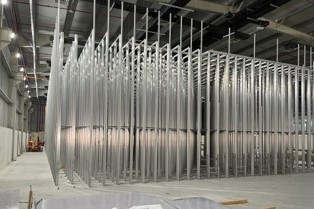
Robotic Cube AS/RS Systems for Efficient Automated Tote Storage
Cube-automated storage and retrieval systems, also known as hive systems, offer a highly efficient solution for automated tote storage. Among the latest advancements in AS/RS technology, robotic cube storage stands out as a cutting-edge option. In these advanced systems, robots operate at the top of the storage cube, performing tasks such as shuffling, sorting, and retrieving bins, and delivering them to designated workstations. The key advantage lies in the synchronized effort of a fleet of robots that navigate tracks atop the grid, seamlessly moving bins out of the system and delivering them to operator ports. These robots operate independently while maintaining a wireless connection to a central controller responsible for managing all operations and traffic algorithms.
The system's structural foundation is an aluminum grid, providing support for the storage totes and a platform for the robots to move efficiently while accessing or storing the totes. Totes are stored in vertical stacks, which the robots skillfully navigate through to retrieve the required tote.
Charging infrastructure is integrated into the solution to ensure that the robots' batteries remain charged and ready for operation.
One of the standout features of robotic cube AS/RS systems is their modularity, making them a highly adaptable choice for accommodating increases in storage volume. This scalability ensures they can meet the evolving needs of businesses efficiently.
Cube AS/RS solutions are versatile and suitable for a wide range of industries and sectors that require storage of small goods within totes. Commonly stored items include auto parts, pharmaceuticals, garments, groceries, and more. They find particular relevance in the ever-expanding direct-to-consumer (D2C) e-commerce sector, where single-item picks are prevalent, enhancing order fulfillment efficiency.
Investing in a robotic cube AS/RS system can revolutionize your storage and retrieval processes, providing speed, precision, and flexibility to meet the demands of modern industries.
Why Are Concrete Floors Vital to Ensure Optimal Cube AS/RS System Performance?
The efficient and safe operation of Cube AS/RS systems rely on a high level of stability. These systems employ automated robotic technologies for precise movements and picking operations in warehouses.
- Cube ASRS Slab Tolerance. Cube AS/RS systems set specific requirements for floor tolerance, emphasizing the need for a flat and stable floor surface. This tolerance is pivotal as it directly impacts the performance of robotic systems. If the concrete floor slab shifts or changes shape after installation, it can disrupt the grid layout and, as a result, negatively affect the performance of the robots, particularly their accuracy in picking items.
It can also affect the structural integrity of the entire ASRS system because the anchors are attached to the floor and if the floor shifts, so does the structure above it. Even the smallest discrepancy in floor level can have far-reaching consequences on the efficiency and accuracy of the robotic operations and the overall reliability of the system. - Challenges Arising from Joints in Cube AS/RS systems: Concrete joints in traditional concrete floors are susceptible to curling, a deformation where the edges of concrete slabs curl upwards. This phenomenon arises from concrete shrinkage, as mentioned earlier. Curling can lead to uneven and non-flat floor surfaces, potentially causing issues critical for cube AS/RS system stability.
- Flexibility and Future-Readiness of Floor Slabs: Cube AS/RS systems, represent long-term investments. Hence, it's imperative for floor slabs to offer flexibility for accommodating future technology expansion. This could entail expanding the existing AS/RS system or integrating additional systems seamlessly.
In summary, concrete floors are pivotal for optimizing the performance of Cube AS/RS. They provide essential stability, meet specific floor tolerance requirements, and mitigate issues related to joints, ensuring precise and seamless operation of robotic technologies. Additionally, they offer the flexibility needed for future technology expansion within these systems.
6 Reasons Why PrimX Concrete Technology is a Game Changer for Cube AS/RS Systems:
- Lifetime Flatness
PrimX's concrete slab remains impeccably flat from the moment of casting and throughout its entire service life, meeting defined tolerance criteria without any curling issues. The exceptional flatness and stability of PrimX mean that it exerts minimal stress on the AS/RS grid structure to which it's anchored. Conventional concrete, especially if it warps or settles, can put strain on the structure and potentially compromise its integrity. That means no slab movement, no potential impact on anchored ASRS grid structure. - Seamless, Jointless Design
Our jointless design offers unmatched flexibility in system placement and expansion, with no worries about curled joint-related problems or anchor placement restrictions. - Reduced CO2 Emissions and Environmental Sustainability:
PrimX's innovative slab design, incorporating a thinner yet load-bearing capacity-enhanced slab, smart material choices, and optimized processes, delivers remarkable CO2 savings while minimizing environmental levies. - Dimensional Stability and Stiffness
PrimX (SFRSSC) Steel Fiber Reinforced Self-Stressing Concrete ensures an exceptionally rigid slab, providing a robust and long-lasting platform for heavy and precision-driven automated systems. - Faster Construction:
Prīm X SFRSSC offers the advantage of being ready for use in just 14 days after pouring. Unlike traditional concrete floors, which necessitate a 30 day curing period. PrīmX lets you get your facility up and running faster. The substantial decrease for steel bar reinforcement in the floors and more efficient and productive construction techniques lead to accelerated construction timelines and enhanced overall efficiency in the building process. - Cost-Efficiency
PrimX's optimized slab design, simplified construction processes, shorter project timelines, and reduced overall costs make it the ideal choice for AS/RS systems.